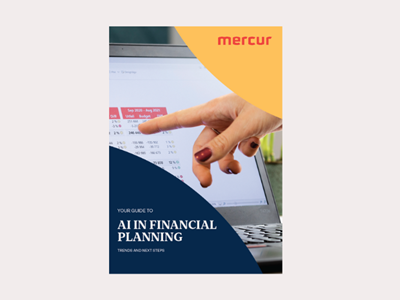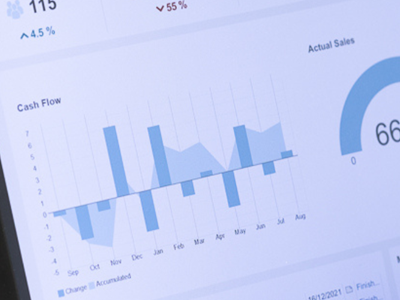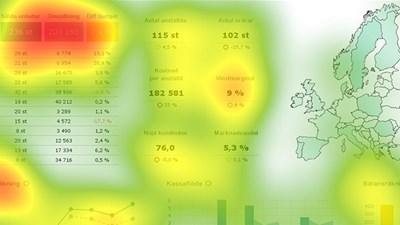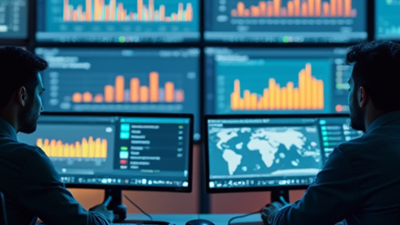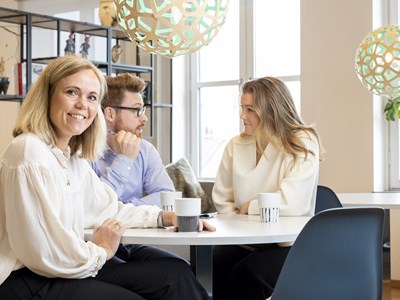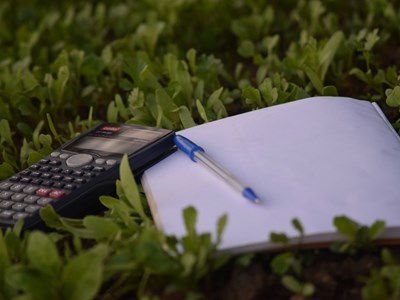
Top 7 Manager KPIs for Financial and Operational success
Every day you're balancing margin goals, strategic initiatives and shifting market conditions - all while keeping teams aligned. But, even the best intentions can fall short without hard data. Without clear performance metrics, decisions become guesswork and progress can stall.
Strategic KPIs give finance leaders and senior managers a reliable view of what's working and what needs to change. The right manager KPIs turn strategy into measurable progress, helping you stay focused on value creation, cost efficency and sustainable growth.
In today's post we'll break down why KPIs matter, which ones offer the most insight for finance and executive teams and how to ensure they're actually driving results.
Why Are Manager KPIs Important?
Too often managers rely on anecdotal evidence or historical habits, only identifying problems after they've caused financial damage.
Take your month-end close process: if your finance team consistently struggles to close the books within the expected timeframe, but there's no agreed definition of 'on time',it's hard to hold anyone accountable or improve efficiency.
A KPI turns an intention into a commitment. 'Improve month-end reporting' is vague. 'Achieve a 3-day month-end close by Q3' is specific, measureable and actionable.
Let's look at the most impcatful KPIs for finance leaders and senior managers!
Top 7 Manager KPIs for Finance Leaders
1. Revenue Growth Rate
Measures top-line momentum, showing whether your strategic initiatives are driving results.
2. Operating Profit Margin
Assesses how efficiently the organisation converts revuenue into profit.
3. Cash Conversion Cycle
Tracks how quickly your company can turn investments in inventory and other resources into cash flow.
4. Employee Turnover Rate
A leading indicator of cultural health and potential cost spikes due to recruitment, onboarding and training.
5. Project ROI
Measures financial return on investment on strategic or capital-intensive projects to ensure resource allocation pays off.
6. Forecast Accuracy
Compareds budgeted or forecasted figures to actual results, helping you identify planning gaps and adapt faster. Want to take it a step further? Expore how scenario planning can strenghten your forecasts.
7. Customer Lifetime Value
Especially important in subscription or repeat-purchase, CLV tie customer retention directly to profitability.
How to choose which KPIs to track
KPIs can sometimes drift into metrics that look impressive but do not have real value for the client. Here is a step-by-step guide to help you determine the right ones:
1. Start with a clear goal
Deciding which KPIs to track should start with a clear aim. First, identify the one or two improvements that will make the biggest difference. A few examples of such improvements include cutting costs in production, lifting customer satisfaction or improving delivery speed. These priorities give your KPIs a direction to follow.
Once you've defined the outcomes that matter the most, draft a handful of action items that speak directly to those goals. This initial step ensures that everything you track serve a purpose rather than just filling space on a dashboard.
2. Link KPIs to Business Goals
Every KPI must connect back to a specific and measurable business objective. If your goal is to increase sales by 10%, a relevant KPI might be the number of new leads generated each week. If you're focused on improving quality, you might track the percentage of products that pass inspection on the first try.
Writing down the exact outcome you seek makes it easier to test whether your KPI actually reflects progress. Without this link to objectives, even a perfectly formatted metric can end up misleading your team.
3. Limit the Number of KPIs
It's easy to overload your reporting with dozens of metrics. However, more isn't always better. Stick to five or six KPIs so that you and your team's attention doesn't scatter.
4. Apply the SMART Test
Even once you've selected your KPIs, they still need to be put through a final filter to ensure they're useful in practise. Make sure each KPI is:
Specific (Know what you measure and how)
Measurable (Ensure data is available and reliable)
Achievable (Set a target that stretches the team without being unrealistic)
Relevant (Tie the measure back to a busines priority)
Time-bound (Give it a deadline or a regular review-cycle)
For instance, 'reduce average order fulfillment time from 48 to 24 hours within six months' meets all the above criteria. Embedding these checks from the start makes your KPIs far more actionable.
5. Ensure Data Reliability
All the planning in the world fails unless your data is consistent, accurate and up to date. Too often, metrics rely on spreadsheets or systems that don't integrate, which slows you down and introduces human error.
The answer is to centralise your data flows. Link your ERP, CRM and any specialist tools to a single solution that refreshes automatically or with minimal delay. Define clear user permissions so that only approced team members can modify critical figures.
6. Turn Data Into Action
A table full of figures won't help unless others know how to interpret it. This is where strong management reporting helps you visualise the data. For this, you can use dashboards that highlight performance at a glance with with visuals like trend lines, progress bars or colour indicators to signal whether each KPI is on track.
In addition, you can set up automatic alerts when a KPI slips out of bounds so you can respond quickly. Scheduling regular check-ins to review results and stay on track is also a good idea. This mix of automation and human insights ensures that KPIs spark action, rather than just sitting pretty in a spreadsheet.
How Mercur Business Control® Supports Smarter KPI Management
Mercur Business Control® consolidates alla your financial and operational data into one system, giving you the clarity you need to lead effectively. Whether you are analysing margin trends, tracking budget variances or forecasting revenue, Mercur empowers you with real-time, reliable insights - no spreadsheets required.
You can define strategic targets, monitor your manager KPIs and drill into the numbers that matter. Seamless ERP, HR, production and sales integrations ensure your data is always accurate and up to date.
Ready to take the guesswork out of performance management?

Contact us today!
Please fill out the form, and we will contact you as soon as possible.
 Blog
BlogBusiness Intelligence Reporting For Finance Teams
The real challenge today isn’t collecting data, it’s making sense of it and fast. Organisations turn to business intelligence (BI) to convert raw data into insight.But how do you actually do it right?
 Blog
BlogAI in Financial Planning: Trends and Next Steps
Discover how finance teams are using AI to drive smarter planning, faster insights, and stronger business decisions.
 Blog
BlogBusiness Budgeting Software: How to Choose the Right One
Choosing budgeting software is partly a finance and partly a strategic decision. The right tool helps organisations organise planning cycles, adapt as the market changes and increase accountability across departments. But not every platform will be a good fit.
 Blog
BlogManagement Reporting Guide: Definition and Tips
Management reporting helps you see what’s really happening in your business. In this guide, we’ll explain what managerial reporting looks like and share practical tips.
 Blog
BlogA practcial guide to scenario planning
Scenario planning gives you a clear, practical way to test assumptions, spot risks and opportunities, and make better strategic choices so your organisation stays resilient when conditions change.
 Blog
BlogSave time and create a successful budget process
If you’re working in a large organization, you’re probably aware of how time-consuming the budget process can be. In this article we’ll give you tips on how to save time and still create a successful budget process
 Blog
BlogHow do finance teams track KPIs across the entire organisation?
Learn how finance teams track KPIs across the entire organisation by consolidating data from multiple sources into a unified system like Mercur.
 Blog
BlogHow EPM Transforms Financial Planning and Forecasting
Struggling to keep plans aligned in a changing market? Discover how EPM helps finance teams move faster, stay accurate and lead with real-time insights.
 Blog
BlogHow to Effectively Budget with Driver-Based Forecasting
Traditional models of forecasting rely on historical data and beliefs. It uses techniques that identify patterns, which are simple to use. However, with these methods, there are some challenges because they are not dynamic with today’s market, and can’t effectively analyse complex data.
 Blog
BlogBetter Revenue Planning
Sales forecasting is the process of predicting future revenue based on past data and trends. Read the blog to learn the best methods to do it right.
 Blog
BlogBoost Report Readability, Engagement, and Decision-Making
In today’s fast-paced business environment, effective reports and dashboards are crucial for decision-making. Our user study using eye-tracking technology revealed seven key insights into what captures attention.
 Blog
BlogAI in corporate budgeting
Artificial Intelligence (AI) can support decision making in key areas such as budgeting, capital allocation and even corporate strategy and as a result, it is increasingly being deployed in corporate performance management tools (CPM).
 Blog
BlogWhat is Corporate Performance Management? (CPM)
CPM, or Corporate Performance Management, is a process within corporate management aimed at measuring and optimizing the performance of an organization. CPM encompasses a range of activities, including budgeting, planning, forecasting, reporting, and analysis.
 Blog
BlogThe Business Benefits of Integrated Business Planning
This blog explores what IBP is and the typical IBP process. We highlight business benefits and how the right software can be a game-changer for your organisation.
 Blog
BlogHow to succeed with your planning, budgeting, and forecasting process
We know it can be challenging to succeed with your planning, budgeting, and forecasting process. Therefore, we have gathered our best tips for you to succeed!
 Blog
BlogSpreadsheet Risk Management: Best Practices for 2025
Excel has long been a target for hackers; just one click on a malicious attachment can infect your entire network. So, how can you keep using spreadsheets while not sacrificing your safety?
 Blog
BlogThe Powerhouse of EPM Tools
A business’s success heavily relies on having a strong strategy. However, what's even more important is implementing that strategy while tracking and measuring the performance. This can easily be done by investing in enterprise performance management (EPM) software.
 Blog
BlogThe Role of the CFO: Top Priorities and Responsibilities
Today's finance leaders steer more than just budgets and reports. The digital transformation ramps up with the increase of corporate complexity, and so does the role of CFOs.
 Blog
BlogWhy is our Excel-based budget always out of date?
Excel creates outdated budgets. Every time someone enters a figure, sends a file, or waits for another department to finish their section, your budget falls further behind reality.
 Blog
Blog3‑Statement Model for Better Financial Forecasting
Financial forecasting is critical for any business that wants to adapt to change. But finance teams keep usingfragmented models and manual processes. The 3-statement financial model is the solution.
 Blog
BlogHow can AI help CFOs make better decisions?
Artificial Intelligence (AI) has significant potential to enhance decision-making for Chief Financial Officers (CFOs) by providing data-driven insights, automating routine tasks, and enabling more accurate forecasts.
 Blog
BlogWhat is management reporting?
Management Reporting refers to the process of creating, analyzing, and presenting information about various aspects of an organization's performance to enable decision-makers to make well-informed decisions about the future.
 Blog
BlogWhat Is FP&A? Definition, Purpose, and Best Practices
Without solid financial planning and analysis (FP&A), businesses operate in the dark. In this post we go deeper into the process of FP&A and why it’s important for businesses.
 Blog
BlogMastering Spreadsheets
Where many businesses start small, a simple spreadsheet can adequately perform the limited tasks required of it. As the company grows, your spreadsheets can get more complex and harder to manage, by which point it feels like it will be too difficult to move to a different reporting tool.
 Blog
BlogAI in Finance as a Powerful Tool
In this post, we explore how AI is evolving from a theoretical concept into a valuable resource for decision-making. Get useful insights for finance teams at any stage, from early exploration to actively using AI-powered solutions.
 Blog
BlogBest Guide to Improve Your Revenue with Flexible Budgeting
Optimise your expenses with flexible budgeting, and learn how to adjust budget to reflect current business activities, market changes and cost fluctuations.
 Blog
BlogHow Automated Reporting Will Transform FP&A in 2026
This article highlights the power of report automation, how to implement it in your business and explores any new opportunities for accurate financial analysis in the long run.
 Blog
BlogInformed Business Decisions at Maximum Velocity
The ability to process information swiftly is essential. If your business can’t manage your data efficiently, your company’s financial performance will surely underperform. At Mercur we have developed our own database Veloxic which helps Financial Planning and Analysis.
 Blog
BlogFive tips for a successful budget process!
How can you make your budget process more successful and maximise the effort that was invested in creating it? Of course, there are many factors to consider but we’ve chosen to highlight five key areas that will enable and help you create a smoother, value-creating and collaborative budget process.
 Blog
BlogFP&A Trends Shaping Financial Planning in 2025
Many organisations cope with fragmented planning and data quality issues, which slow down their forecasting cycles. This forces organisations to take practical steps to turn ambition into execution.
 Blog
BlogHow to get accurate financial reports without waiting for month-end
You don't need to wait until month-end to see accurate financial reports. With modern financial systems you can access up-to-date reports whenever you need them.
 Blog
BlogFrom static budgets to agile financial management
Traditional budgeting has long been the cornerstone of financial planning in businesses. But today it can become more of a limitation than a strength. That’s where the concept of Beyond Budgeting comes in.
 Blog
BlogThe Collaborative, Smarter Budget
In many organisations manual budgeting processes over-burden staff and create masses of data which overwhelms department heads and stops them seeing the bigger picture.
 Blog
BlogBuild Long-Range Planning for Business Success
Discover how effective long-range planning aligns strategy, finance and operations for smarter decisions and sustainable growth.
 Blog
BlogRisks with working in spreadsheets
Spreadsheets are an essential tool for all types of organisations and businesses rely on them heavily, particularly for financial computations. The most popular spreadsheet program globally is, of course, Microsoft Excel, it’s used by an estimated 750 million people.
 Blog
BlogBudgeting in a modern world
Thirty years after its debut, Microsoft Excel is still the preferred tool for budgeting and planning projects. However, its popularity is declining, due in most part to the rise of technology and subscription-based pricing for a myriad of SaaS-based products.
 Blog
BlogThe Hidden Cost of Data Silos
If you ever feel like your teams speak different languages when it comes to data, it is a classic symptom of data silos. The information gets stuck in one department, system or tool, making it difficult for anyone to see the full picture.
 Blog
BlogAI and Machine Learning, what is it, and why is it important for the future?
Artificial Intelligence and Machine Learning, what is it, and what is the difference?
 Blog
BlogHow To Create a Successful Budgeting Process
When done well, budgeting helps organisations stay financially on course, even when things don’t go exactly as planned. Learn how to keep things on track so you avoid surprises and stay focused on your goals.
 Blog
BlogVariance Analysis: A Comprehensive Guide
Senior executives are demanding more detail in their management reports. The amount of data available to finance departments has exploded and decision makers see this as an opportunity to get more insight into how the business is performing.
 Blog
BlogWhat Is Planning, Budgeting and Forecasting?
Planning, budgeting and forecasting are rarely static. Shifts in the industry often require you to revisit assumptions, adjust targets and adopt new processes. Learn how to strengthen your approach and stay ahead of change.
 Blog
BlogRolling Forecasts: Practical Steps, Benefits, and How to Get Started
Financial planning has changed. Traditional annual budgets can’t keep up with rapid shifts in the market, evolving customer needs, and internal performance dynamics. That’s why many finance teams are turning to a rolling forecast model.
 Blog
BlogCFO Playbook - KPIs for 2026
The role of the CFO is changing fast. Today, the finance function is expected to deliver more than reports — it must drive direction, speed and profitability through clear, actionable KPIs. Learn more in this guide.
 Blog
BlogSpreadsheets Risk the Future of the Business
Spreadsheets often start as just a list for storing information and there is minimal process documentation, support or maintenance for these worksheets. Despite the fact that desktop applications such as Microsoft Office are included in the standard configuration of users' PCs, very little formal training is ever given to spreadsheet users.
 Blog
BlogWhy xP&A is a powerful game-changer
The newest iteration of planning, analysis and reporting systems is a powerful game-changer that unites company departments and boosts competitiveness. It’s called xP&A – the abbreviation of extended financial planning and analysis.
 Blog
BlogTop-Down vs Bottom-Up Budgeting
Budgeting aligns resources with strategic goals, and there are two primary approaches: top-down and bottom-up. Which method wroks best?
 Blog
BlogSpreadsheets are not Collaborative Tools
Spreadsheets were never designed for collaboration, yet they are the single most used program among teams and co-workers. They often start out as a quick document for storing, formatting or calculating information but evolve into important documents and are often the core records for an organisation.
 Blog
BlogBalancing Profitability and Sustainability
Sustainability has become a central concern for organisations across the world — and the UK is no exception. This evolving landscape places new demands on financial reporting.
 Blog
BlogZero-Based vs. Incremental Budgeting
Budgeting sits at the heart of sound financial management. This is why choosing the right technique is crucial for CFOs – it shapes resource allocation, cost control and strategic agility. Incremental and zero-based budgeting are two leading methods that offer distinct approaches.
 Blog
BlogCash Flow Forecasting
Inaccurate cash flow forecasting can be a costly mistake for companies. In today’s volatile market, relying on static annual budgets or manual spreadsheets leaves financial leaders without the agility to respond to uncertainty.
 Blog
BlogScenario Planning - Better control during uncertain times
Uncertain times create the need for more frequent forecasts and time for analyzing and comparing different future scenarios. We give you 5 tips on how to simulate future scenarios using scenario planning
 Blog
BlogTop PowerBI Alternatives in 2025
Explore the top PowerBI alternatives for 2025. Discover how Mercur delivers integrated planning, budgeting and reporting without the high cost and complexity.


